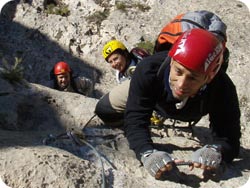Via Ferrata
Via Ferrata, meaning “iron road or way” in Italian, was conceived during World War 1 when the Italian and Austrian forces were engaged in ferocious battles to gain control of their frontiers mainly in the mountainous Dolomite region.
Thousands of troops died. To assist troop movements at high altitudes the forces fixed wire lines and ladders to the rock faces enabling their soldiers to gain control of the upper peaks. These were the first Via Ferrata routes.
 Today the major region for modern Via Ferrata routes is the Dolomites but many other countries have now constructed their own routes. From the desperate needs of war time we now have a major mountain sport which can be enjoyed by thousands of people a year.
Today the major region for modern Via Ferrata routes is the Dolomites but many other countries have now constructed their own routes. From the desperate needs of war time we now have a major mountain sport which can be enjoyed by thousands of people a year.
Modern Via Ferrata routes consist of steel cables bolted into the rock face at intervals and running parallel with metal rungs or stemples.
A Via Ferrata belay device is essential and consists of two energy absorbing tails with karabiners. This assembly is tied into the normal climbing harness with one karabiner being attached to the cable at all times. Via Ferrata is similar to rock climbing but with different risks and fall factors. Via Ferrata videos can be seen on Youtube.
See our Photo Gallery.
Our Via Ferrata activities cover the Valencia and Catalunya Regions.

 MENU
MENU



